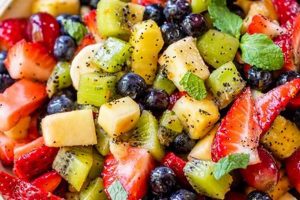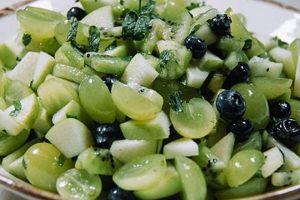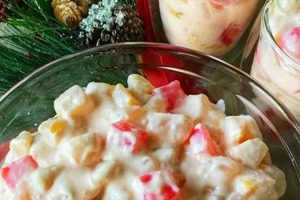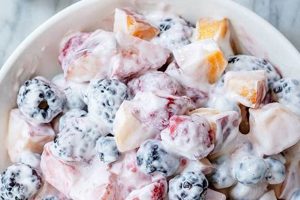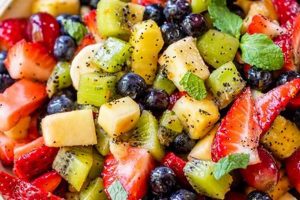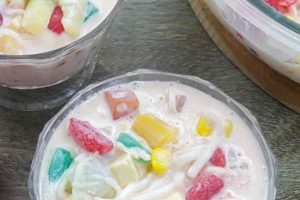A fall-inspired fruit salad blends the season’s bounty into a refreshing and flavorful dish. Apples, pears, and grapes, often combined with pomegranate seeds and citrus segments, characterize these recipes. A simple example could include diced apples and pears tossed with red grapes, pomegranate arils, and a light dressing of orange juice and cinnamon.
Seasonal eating offers several advantages. Utilizing peak-season produce maximizes flavor and nutritional value while supporting local agriculture. Historically, preserving the harvest through methods like drying or incorporating fruits into dishes such as compotes and salads was essential for sustenance through colder months. This practice continues to inspire contemporary autumnal recipes.
This article will explore various fall fruit combinations, discussing optimal ingredient selection, preparation techniques, and complementary dressings to create the perfect seasonal salad. It will also offer suggestions for incorporating nuts, spices, and other elements to enhance flavor and texture.
Tips for Creating an Autumnal Fruit Salad
The following tips offer guidance for composing a balanced and flavorful fall fruit salad.
Tip 1: Select Peak-Season Produce: Opt for fruits at their peak ripeness for optimal flavor and texture. Look for crisp apples like Honeycrisp or Fuji, firm pears such as Bosc or Anjou, and plump, juicy grapes.
Tip 2: Balance Sweet and Tart Flavors: Combine sweeter fruits like apples and pears with tart elements like pomegranate seeds or citrus segments for a more complex flavor profile.
Tip 3: Consider Texture: Incorporate a variety of textures. Pair softer fruits with crisp elements like apple slices or pomegranate arils.
Tip 4: Enhance with Spices: A touch of cinnamon, nutmeg, or ginger can complement the natural sweetness of the fruit and enhance the autumnal theme.
Tip 5: Add Nuts or Seeds: Toasted pecans, walnuts, or pumpkin seeds provide a satisfying crunch and add nutritional value.
Tip 6: Dress Lightly: A simple dressing of orange juice, maple syrup, or a light vinaigrette enhances the fruit’s natural flavors without overpowering them.
Tip 7: Prepare Ingredients Properly: Prevent browning by tossing cut apples and pears with a little lemon juice. Chill the salad before serving for optimal freshness.
By following these tips, one can create a delicious and visually appealing fruit salad that captures the essence of autumn.
By understanding the principles of flavor balance, texture, and seasonal ingredients, crafting an exceptional autumnal fruit salad becomes readily achievable.
1. Seasonal Ingredients
The concept of a “fruit salad recipe autumn” hinges upon the availability and utilization of seasonal ingredients. Fall harvests offer a distinct array of fruits reaching peak ripeness, imbuing the salad with optimal flavor and nutritional value. Apples, pears, and grapes exemplify quintessential autumnal produce, providing a foundation of sweetness and texture. The inclusion of ingredients like pomegranates, cranberries, and persimmons further amplifies the seasonal character, reflecting the specific flavors associated with the fall harvest. Choosing produce at its peak ripeness not only maximizes flavor but also supports local agriculture and reduces the environmental impact associated with long-distance transportation.
The selection of specific apple varieties, for instance, demonstrates the nuanced connection between seasonal ingredients and recipe development. A Honeycrisp apple, harvested in early autumn, offers a crisp, sweet-tart flavor profile well-suited for salads. Conversely, a later-season Fuji apple provides a firmer texture and sweeter taste, lending itself to different applications within the salad. Similarly, the inclusion of late-season grapes, such as Concords, introduces a depth of flavor unavailable earlier in the year. These examples illustrate how an understanding of seasonal availability influences ingredient choices and, consequently, the overall composition of the salad.
Prioritizing seasonal ingredients in an autumnal fruit salad yields a dish reflective of the time of year, maximizing both flavor and nutritional content. Challenges may arise in regions with limited access to specific fall produce. However, adapting recipes to incorporate locally available alternatives allows for the creation of equally compelling seasonal salads. Ultimately, embracing seasonality allows for a deeper appreciation of the interconnectedness between food, agriculture, and the cyclical nature of the seasons.
2. Flavor Balance
Flavor balance forms a cornerstone of successful autumnal fruit salads. The inherent sweetness of fall fruits necessitates careful consideration of contrasting flavors. A harmonious blend of sweet, tart, and potentially tangy or even slightly bitter elements elevates the salad beyond a simple collection of ingredients. This balance prevents the overall flavor profile from becoming monotonous, ensuring a more complex and enjoyable sensory experience. For instance, the sweetness of ripe pears can be offset by the tartness of cranberries or the tang of citrus segments, creating a dynamic interplay that engages the palate.
Achieving this balance requires an understanding of the individual flavor profiles of each ingredient. Apples, while generally sweet, exhibit a spectrum of sweetness and tartness depending on the variety. Pairing a sweeter apple like Fuji with a tart counterpart like Granny Smith provides a foundational flavor contrast. Further complexity can be introduced through the incorporation of spices. A hint of cinnamon or nutmeg complements the natural sweetness of the fruit, while a pinch of ginger adds a subtle warmth and complexity. Even the inclusion of ingredients like toasted nuts or crumbled cheese contributes to flavor balance by introducing savory or earthy notes that counterpoint the fruit’s sweetness.
Understanding flavor balance in the context of an autumnal fruit salad allows for informed ingredient selection and strategic flavor pairings. This knowledge translates to the creation of salads that are not only visually appealing but also offer a layered and nuanced flavor experience. The potential challenges lie in overemphasizing one flavor profile at the expense of others. Over-sweetening a salad, for instance, can mask the subtle nuances of other ingredients. Careful consideration of each element’s contribution to the overall flavor composition is crucial for achieving a well-balanced and ultimately satisfying autumnal fruit salad.
3. Textural Variety
Textural variety elevates an autumnal fruit salad from simply palatable to genuinely engaging. A combination of textures offers a more stimulating sensory experience, enhancing enjoyment and adding complexity. This principle involves incorporating a range of texturesfrom crisp and crunchy to soft and yieldingto create a dynamic interplay within each bite. The careful consideration of textural contrast distinguishes a well-composed salad from a homogenous mixture.
- Crisp Elements
Crisp components provide a satisfying crunch. Examples include apple slices, pomegranate arils, and toasted nuts. These elements contrast with softer fruits, preventing a uniformly soft texture. In a fall salad, the crispness of a Honeycrisp apple provides a refreshing counterpoint to the softer texture of ripe grapes.
- Soft Elements
Softer fruits contribute a yielding texture and often a burst of juice. Ripe pears, berries, and segments of citrus fruits exemplify this category. These elements provide a textural contrast to crisper components and contribute to the overall balance of the salad. The softness of a ripe Comice pear complements the crisp bite of an apple.
- Chewy Elements
Dried fruits, such as cranberries or chopped dates, introduce a chewy texture. This element adds another layer of complexity, offering a different mouthfeel compared to fresh fruit. The chewiness of dried cranberries provides a textural contrast to the other ingredients in the salad.
- Crunchy Elements
Toasted nuts or seeds amplify the textural profile by providing a pronounced crunch. Pecans, walnuts, or pumpkin seeds enhance the salad’s sensory appeal and contribute nutritional value. The crunch of toasted pecans complements the other textures and adds a layer of complexity.
The interplay of these textural elements creates a multi-faceted eating experience. A well-composed autumnal fruit salad utilizes contrasting textures to create a dynamic and satisfying culinary experience. The strategic combination of crisp apples, soft pears, chewy dried cranberries, and crunchy toasted pecans exemplifies how textural variety transforms a simple fruit salad into a more complex and enjoyable dish.
4. Complementary Dressings
Complementary dressings play a crucial role in enhancing the flavor profile of an autumnal fruit salad. The dressing should complement, not overpower, the natural sweetness and nuanced flavors of the seasonal fruits. A well-chosen dressing elevates the salad, unifying the diverse ingredients and adding a finishing touch that enhances the overall sensory experience. The wrong dressing, however, can mask the delicate flavors of the fruit, resulting in a less satisfying dish. Therefore, careful consideration of dressing options is essential.
- Light Vinaigrettes
Light vinaigrettes offer a balanced approach, providing acidity without overwhelming the fruit. A simple vinaigrette made with apple cider vinegar, a touch of maple syrup, and a neutral oil like grapeseed oil enhances the natural sweetness of the fruit while adding a subtle tang. The acidity of the vinegar also helps to brighten the flavors and prevent the fruit from oxidizing.
- Citrus-Based Dressings
Citrus-based dressings contribute brightness and zest. Freshly squeezed orange or grapefruit juice, combined with a hint of honey or maple syrup, creates a vibrant dressing that complements the flavors of fall fruits. The citrus notes add a refreshing element that balances the sweetness of apples and pears, while the touch of sweetener provides a cohesive element.
- Maple-Infused Dressings
Maple syrup, a quintessential autumnal flavor, lends itself well to fruit salad dressings. A simple dressing of maple syrup whisked with a touch of lemon juice and a pinch of cinnamon creates a warm and inviting flavor profile that complements the seasonal fruit. The maple syrup adds a touch of sweetness and depth, while the lemon juice provides a balancing acidity.
- Yogurt-Based Dressings
Greek yogurt offers a creamy and tangy base for dressings. Combining Greek yogurt with honey, a squeeze of lemon, and a dash of vanilla extract creates a dressing that adds a creamy texture and a subtle tang to the fruit salad. This option provides a richer, more decadent alternative to lighter vinaigrettes, particularly suitable for salads featuring heavier fruits like apples and pears.
The selection of a complementary dressing depends on the specific fruits in the salad and the desired overall flavor profile. A lighter vinaigrette might be preferred for a salad featuring a variety of delicate fruits, while a richer, yogurt-based dressing might complement a salad with heartier fruits. Ultimately, the goal is to enhance, not mask, the natural flavors of the autumnal produce, creating a harmonious and balanced culinary experience. The interplay between the fruit and the dressing elevates the simple fruit salad to a more sophisticated and flavorful dish, capturing the essence of the autumn season.
5. Presentation
Presentation elevates an autumnal fruit salad from a simple dish to a visually appealing culinary creation. Thoughtful arrangement and attention to detail enhance the dining experience, engaging multiple senses and reflecting the care taken in preparation. While flavor and texture remain paramount, presentation contributes significantly to the overall perception and enjoyment of the salad.
- Color Palette
Autumnal fruit salads offer a naturally vibrant color palette. The deep reds of pomegranates, the warm oranges of persimmons, the rich purples of grapes, and the varying hues of apples and pears provide a visually appealing foundation. Arranging these fruits strategically emphasizes their natural colors and creates an aesthetically pleasing composition. A deliberate arrangement might group similar colors together for a monochromatic effect or alternate contrasting colors for a more dynamic presentation.
- Cutting Techniques
Varying cutting techniques adds visual interest and textural diversity. Apples can be diced, sliced, or fanned, while pears can be quartered, sliced, or scooped into elegant balls. Grapes can be left whole or halved, and larger fruits like pomegranates can be seeded and scattered across the salad. These varied shapes and sizes create a visually appealing texture and contribute to a more dynamic presentation.
- Serving Vessels
The choice of serving vessel impacts the presentation. A rustic wooden bowl enhances the autumnal theme, while a clear glass bowl showcases the vibrant colors of the fruit. Individual portions in small glasses or bowls create an elegant and personalized touch. The serving vessel should complement the salad’s aesthetic and the overall dining setting.
- Garnishes
A simple garnish provides a finishing touch. A sprinkle of chopped nuts, a scattering of fresh herbs like mint or rosemary, or a dusting of powdered sugar or cinnamon adds a final layer of visual appeal and can enhance the aroma and flavor. Edible flowers, chosen carefully to complement the fruit, can also elevate the presentation to a more sophisticated level.
The presentation of an autumnal fruit salad demonstrates attention to detail and enhances the overall dining experience. By considering color, cutting techniques, serving vessels, and garnishes, one transforms a simple mixture of fruit into a visually appealing and memorable dish. These elements, combined with the inherent flavors and textures of the seasonal produce, create a complete sensory experience that celebrates the essence of autumn.
Frequently Asked Questions
This section addresses common inquiries regarding autumnal fruit salads, offering practical guidance and clarifying potential uncertainties.
Question 1: How can enzymatic browning of fruits like apples and pears be prevented?
A light coating of lemon juice or ascorbic acid (vitamin C) inhibits oxidation, preserving the fruit’s appearance and preventing discoloration.
Question 2: What dressings best complement the flavors of an autumnal fruit salad?
Light vinaigrettes with apple cider vinegar or citrus-based dressings with a touch of maple syrup or honey enhance the natural sweetness without overpowering the delicate flavors.
Question 3: How can an autumnal fruit salad be made more substantial?
Adding toasted nuts, seeds, or crumbled cheese provides healthy fats, protein, and textural complexity, transforming the salad into a more satisfying dish.
Question 4: What spices enhance the flavors of fall fruits?
Cinnamon, nutmeg, ginger, and allspice complement the sweetness of apples, pears, and other autumnal fruits, adding warmth and depth.
Question 5: How long can an autumnal fruit salad be stored?
Properly stored in an airtight container in the refrigerator, a fruit salad can typically be enjoyed for up to three days, though optimal flavor and texture are best within the first 24 hours.
Question 6: Can frozen fruit be used in an autumnal fruit salad?
While fresh, seasonal fruit is ideal, frozen fruits can be substituted. Ensure they are fully thawed and drained before adding to the salad to avoid excess moisture.
Careful selection of ingredients, balanced flavor profiles, and attention to presentation contribute to a successful autumnal fruit salad. Addressing these common questions facilitates informed decision-making throughout the preparation process.
The following section offers a curated selection of autumnal fruit salad recipes, providing practical examples for incorporating the principles discussed above.
Conclusion
Exploration of autumnal fruit salad recipes reveals the interplay of seasonal ingredients, flavor balance, textural variety, complementary dressings, and thoughtful presentation. Prioritizing peak-season produce ensures optimal flavor and nutritional value. Balancing sweet and tart components, incorporating diverse textures, and selecting appropriate dressings create a harmonious and engaging sensory experience. Attention to visual appeal elevates the dish, transforming a simple combination of ingredients into a culinary expression of the season.
Successful execution of these principles yields a dish reflective of autumn’s bounty. The creation of an autumnal fruit salad offers an opportunity to engage with seasonal ingredients and explore the dynamic interplay of flavors and textures. This culinary endeavor provides a tangible connection to the natural world and the cyclical rhythm of the seasons, demonstrating the potential for culinary creativity within the context of seasonal eating. Continued exploration of flavor profiles and presentation techniques offers limitless possibilities for crafting unique and satisfying autumnal fruit salads.

